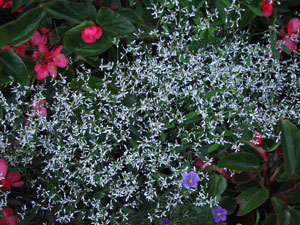Resource Library
Plant of the Week: Spurge, Snowy
The University of Arkansas System Division of Agriculture does not promote, support or recommend plants featured in "Plant of the Week." Please consult your local Extension office for plants suitable for your region.
Plant of the Week
Snowy Spurge
Latin: Chamaesyce hypericifolia ‘Inneuphdia’

In the garden world, it is becoming increasingly important to have new products to attract the attention and fire the imagination of the gardener (customer). The bar to call something new and improved is pretty low, so lots of hype is little more than mere lip-flapping. But occasionally, as in the case of the snowy spurge (Chamaesyce hypericifolia ‘Inneuphdia’), plants do appear that live up to their hype and become established as a new, worthwhile garden addition.
Snowy spurge, a name I shamelessly admit to inventing, is a compact, free-flowering annual growing to about 18 inches tall and wide with white “flowers” produced all summer in an open mass reminiscent of baby’s breath. Plants are extremely free-branching. Leaves are, depending on the position on the stem, from 1 and a quarter to 2 inches in length, opposite and smoothly glabrous.
Leaves, however, are hidden by the open, airy, freely branched cyme that produces hundreds of inch-wide airy flowers. The flowers are typical of the euphorbia family in that the true flower is a small, five-petaled nub in the center of the floral whorl that produces a cyathia, the true reproductive structure found in euphorbias. The color display is produced by two to three white, spatula-shaped bracts that are about half an inch long and produced just below the true flower. Individual bracts remain colorful for about 10 days, but the plant continues to open new blossoms each day, so hundreds of flowers are doing their thing at any one time.
Snowy spurge burst onto the garden scene in 2005 as Euphorbia hypericifolia ‘Inneuphdia’, and received plant patent protection in 2007 as PP 17567. The inventor designated on the patent is Gary Grueber of Mainz, Germany, who found the plant as a whole plant mutation in a population of plants he was growing in a poly greenhouse in the spring of 2004. Grueber was one of the founders of the international network of growers who established the Proven Winner brand of vegetatively propagated plants in the mid-90s.
The plant was marketed under the trademarked name ‘Diamond Frost’ and sold as one of the Proven Winner plants. In 2008, Ball Floral introduced a competing line called the “Breathless Series,” another trademarked name, which included a more compact white form and a pink-tinted type. Their take on correct botanical nomenclature placed the plant in the genus Chamaesyce, a group of common weeds belonging to the large spurge family.
Plants too can have an identity crisis. The USDA recognizes the genus Chamaesyce and uses the common name of “sandmat” to describe the genus of more than 80 species. The most common of these is the annual garden weed called prostrate spurge, I, which has the form of a paper plate – flat and round with tiny leaves and flowers and a single taproot. DNA sequencing data rejects the wisdom of separating these plants from Euphorbia, but many taxonomists argue they are distinct enough to split off into their own group. A better common name, such as the proposed snowy spurge, is needed for these new plants because the common name of sandmat seems ill-fitted and the trade names are all trademarked, thus complicating the naming issue for those writing about the plants or producing garden catalogs.
Snowy spurge has won recognition in almost every plant trial in which it has been planted. Given warm, sunny conditions and enough water to get it established, the plant is virtually maintenance-free. And once it starts blooming, it will continue to do so until frost without need to deadhead, shear back or otherwise do anything. The plant has great drought and heat tolerance, insect and disease resistance and is deer-proof. In the three years I have observed the plants, there is no indication they produce viable seed, so reseeding is not a concern. The white, subtle flowers make it a perfect companion plant in bedding schemes or for use in container plantings.
By: Gerald Klingaman, retired
Extension Horticulturist - Ornamentals
Extension News - September 10, 2010
The University of Arkansas System Division of Agriculture does not maintain lists of retail outlets where these plants can be purchased. Please check your local nursery or other retail outlets to ask about the availability of these plants for your growing area.